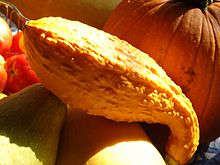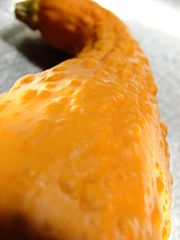Crookneck squash: Difference between revisions
removed Category:Cucurbitaceae using HotCat |
Rescuing 1 sources and tagging 0 as dead. #IABot (v1.5beta) |
||
| Line 11: | Line 11: | ||
'''Crookneck squash''' is a [[cultivar]] of ''[[Cucurbita pepo]]'',<ref name=WSU>{{cite web|title=Zucchetta |url=http://agsyst.wsu.edu/zucchetta.html |work=Mount Vernon Northwestern Washington Research and Extension Center: Vegetable Research and Extension|publisher=[[Washington State University]]|accessdate=10 May 2013}}</ref> the species that also includes some [[pumpkin]]s and most other [[summer squash]]es. The plants are bushy{{r|WSU}} and do not spread like the plants of winter squash and pumpkin.<ref name=UoI>{{cite web|title=Summer Squash|url=http://urbanext.illinois.edu/veggies/ssquash.cfm|work=Watch Your Garden Grow|publisher=University of Illinois Extension|accessdate=14 May 2013}}</ref> Most often used as a [[summer squash]], it is characterized by its yellow skin (which may be smooth or bumpy){{r|UoI}} and sweet yellow flesh, as well as its distinctive curved stem-end or "crooked neck".<ref name=UDC>{{cite web|title=Summer Squash|url=http://www.udc.edu/docs/causes/online/SummerSquash%2015.pdf|publisher=University of the District of Columbia Cooperative Extension Service|accessdate=14 May 2013}}</ref> It should not be confused with crookneck cultivars of ''[[Cucurbita moschata]]'', such as the [[winter squash]] 'Golden Cushaw',<ref>{{cite book|author1=Phillips, R. |author2=Rix, M. |year=1993|title=Vegetables|publisher=Random House|location=New York}}</ref> or the [[vine|vining]] summer squash '[[Tromboncino (squash)|Tromboncino]]'.{{r|WSU}} Its name distinguishes it from another similar-looking variety of ''C. pepo'', the [[straightneck squash]], which is also usually yellow.<ref name="saade">{{cite web |last1=Saade |first1=R. Lira |last2=Hernández |first2=S. Montes |title=Cucurbits |url=http://www.hort.purdue.edu/newcrop/1492/cucurbits.html |publisher=Purdue Horticulture |accessdate=September 2, 2013}}</ref><ref name="mbccp">{{cite web |url=http://www.missouribotanicalgarden.org/gardens-gardening/your-garden/plant-finder/plant-details/kc/a686/cucurbita-pepo.aspx |publisher=Missouri Botanical Garden |title=''Cucurbita pepo'' |accessdate=September 2, 2013}}</ref><ref name="heistinger">{{cite book |last=Heistinger |first=Andrea |title=The Manual of Seed Saving: Harvesting, Storing, and Sowing Techniques for Vegetables, Herbs, and Fruits |publisher=Timber Press |location=Portland, OR|year=2013 |page=278 |isbn=978-1-60469-382-9}}</ref> There is one similar non-edible C. pepo variety: ''C. pepo'' var. ''ovifera''.<ref name="decker">{{cite journal | last1 = Decker | first1 = Deena S. | last2 = Wilson | first2 = Hugh D. | year = 1987 | title = Allozyme Variation in the ''Cucurbita pepo'' Complex: ''C. pepo'' var. ''ovifera'' vs. ''C. texana'' | journal = [[Systematic Botany]] | volume = 12 | issue = 2 | pages = 263–273 | publisher = American Society of Plant Taxonomists | jstor = 2419320 | doi = 10.2307/2419320}}</ref> |
'''Crookneck squash''' is a [[cultivar]] of ''[[Cucurbita pepo]]'',<ref name=WSU>{{cite web|title=Zucchetta |url=http://agsyst.wsu.edu/zucchetta.html |work=Mount Vernon Northwestern Washington Research and Extension Center: Vegetable Research and Extension|publisher=[[Washington State University]]|accessdate=10 May 2013}}</ref> the species that also includes some [[pumpkin]]s and most other [[summer squash]]es. The plants are bushy{{r|WSU}} and do not spread like the plants of winter squash and pumpkin.<ref name=UoI>{{cite web|title=Summer Squash|url=http://urbanext.illinois.edu/veggies/ssquash.cfm|work=Watch Your Garden Grow|publisher=University of Illinois Extension|accessdate=14 May 2013}}</ref> Most often used as a [[summer squash]], it is characterized by its yellow skin (which may be smooth or bumpy){{r|UoI}} and sweet yellow flesh, as well as its distinctive curved stem-end or "crooked neck".<ref name=UDC>{{cite web|title=Summer Squash|url=http://www.udc.edu/docs/causes/online/SummerSquash%2015.pdf|publisher=University of the District of Columbia Cooperative Extension Service|accessdate=14 May 2013}}</ref> It should not be confused with crookneck cultivars of ''[[Cucurbita moschata]]'', such as the [[winter squash]] 'Golden Cushaw',<ref>{{cite book|author1=Phillips, R. |author2=Rix, M. |year=1993|title=Vegetables|publisher=Random House|location=New York}}</ref> or the [[vine|vining]] summer squash '[[Tromboncino (squash)|Tromboncino]]'.{{r|WSU}} Its name distinguishes it from another similar-looking variety of ''C. pepo'', the [[straightneck squash]], which is also usually yellow.<ref name="saade">{{cite web |last1=Saade |first1=R. Lira |last2=Hernández |first2=S. Montes |title=Cucurbits |url=http://www.hort.purdue.edu/newcrop/1492/cucurbits.html |publisher=Purdue Horticulture |accessdate=September 2, 2013}}</ref><ref name="mbccp">{{cite web |url=http://www.missouribotanicalgarden.org/gardens-gardening/your-garden/plant-finder/plant-details/kc/a686/cucurbita-pepo.aspx |publisher=Missouri Botanical Garden |title=''Cucurbita pepo'' |accessdate=September 2, 2013}}</ref><ref name="heistinger">{{cite book |last=Heistinger |first=Andrea |title=The Manual of Seed Saving: Harvesting, Storing, and Sowing Techniques for Vegetables, Herbs, and Fruits |publisher=Timber Press |location=Portland, OR|year=2013 |page=278 |isbn=978-1-60469-382-9}}</ref> There is one similar non-edible C. pepo variety: ''C. pepo'' var. ''ovifera''.<ref name="decker">{{cite journal | last1 = Decker | first1 = Deena S. | last2 = Wilson | first2 = Hugh D. | year = 1987 | title = Allozyme Variation in the ''Cucurbita pepo'' Complex: ''C. pepo'' var. ''ovifera'' vs. ''C. texana'' | journal = [[Systematic Botany]] | volume = 12 | issue = 2 | pages = 263–273 | publisher = American Society of Plant Taxonomists | jstor = 2419320 | doi = 10.2307/2419320}}</ref> |
||
Yellow crookneck squash are generally harvested immature, when they are less than two inches in diameter,{{r|UoI}}{{r|UDC}} since the skin toughens and the quality degrades as the squash reaches full maturity.<ref name=USU>{{cite web|title=Summer and Winter Squash|url=http://extension.usu.edu/yardandgarden/htm/vegetables_herbs/summer-and-winter-squash|publisher=Utah State University Cooperative Extension|accessdate=14 May 2013}}</ref> |
Yellow crookneck squash are generally harvested immature, when they are less than two inches in diameter,{{r|UoI}}{{r|UDC}} since the skin toughens and the quality degrades as the squash reaches full maturity.<ref name=USU>{{cite web|title=Summer and Winter Squash|url=http://extension.usu.edu/yardandgarden/htm/vegetables_herbs/summer-and-winter-squash|publisher=Utah State University Cooperative Extension|accessdate=14 May 2013|deadurl=yes|archiveurl=https://web.archive.org/web/20130610004852/http://extension.usu.edu/yardandgarden/htm/vegetables_herbs/summer-and-winter-squash|archivedate=10 June 2013|df=}}</ref> |
||
== References == |
== References == |
||
Revision as of 19:52, 14 August 2017
| Cucurbita pepo 'Yellow crookneck' | |
|---|---|
 Crookneck squash along with other types of squash | |
| Species | Cucurbita pepo |
| Cultivar | Yellow crookneck |
| Origin | Eastern North America |
| Nutritional value per 100 g (3.5 oz) | |
|---|---|
| Energy | 19 kcal (79 kJ) |
3.9 g | |
| Dietary fiber | 1.0 g |
0.3 g | |
1.0 g | |
| Vitamins | Quantity %DV† |
| Riboflavin (B2) | 3% 0.04 mg |
| Vitamin C | 21% 19 mg |
| Minerals | Quantity %DV† |
| Potassium | 7% 222 mg |
| Other constituents | Quantity |
| Water | 94 g |
| †Percentages estimated using US recommendations for adults,[1] except for potassium, which is estimated based on expert recommendation from the National Academies.[2] | |
Crookneck squash is a cultivar of Cucurbita pepo,[3] the species that also includes some pumpkins and most other summer squashes. The plants are bushy[3] and do not spread like the plants of winter squash and pumpkin.[4] Most often used as a summer squash, it is characterized by its yellow skin (which may be smooth or bumpy)[4] and sweet yellow flesh, as well as its distinctive curved stem-end or "crooked neck".[5] It should not be confused with crookneck cultivars of Cucurbita moschata, such as the winter squash 'Golden Cushaw',[6] or the vining summer squash 'Tromboncino'.[3] Its name distinguishes it from another similar-looking variety of C. pepo, the straightneck squash, which is also usually yellow.[7][8][9] There is one similar non-edible C. pepo variety: C. pepo var. ovifera.[10]
Yellow crookneck squash are generally harvested immature, when they are less than two inches in diameter,[4][5] since the skin toughens and the quality degrades as the squash reaches full maturity.[11]
References
- ^ United States Food and Drug Administration (2024). "Daily Value on the Nutrition and Supplement Facts Labels". FDA. Archived from the original on 2024-03-27. Retrieved 2024-03-28.
- ^ National Academies of Sciences, Engineering, and Medicine; Health and Medicine Division; Food and Nutrition Board; Committee to Review the Dietary Reference Intakes for Sodium and Potassium (2019). Oria, Maria; Harrison, Meghan; Stallings, Virginia A. (eds.). Dietary Reference Intakes for Sodium and Potassium. The National Academies Collection: Reports funded by National Institutes of Health. Washington, DC: National Academies Press (US). ISBN 978-0-309-48834-1. PMID 30844154. Archived from the original on 2024-05-09. Retrieved 2024-06-21.
- ^ a b c "Zucchetta". Mount Vernon Northwestern Washington Research and Extension Center: Vegetable Research and Extension. Washington State University. Retrieved 10 May 2013.
- ^ a b c "Summer Squash". Watch Your Garden Grow. University of Illinois Extension. Retrieved 14 May 2013.
- ^ a b "Summer Squash" (PDF). University of the District of Columbia Cooperative Extension Service. Retrieved 14 May 2013.
- ^ Phillips, R.; Rix, M. (1993). Vegetables. New York: Random House.
- ^ Saade, R. Lira; Hernández, S. Montes. "Cucurbits". Purdue Horticulture. Retrieved September 2, 2013.
- ^ "Cucurbita pepo". Missouri Botanical Garden. Retrieved September 2, 2013.
- ^ Heistinger, Andrea (2013). The Manual of Seed Saving: Harvesting, Storing, and Sowing Techniques for Vegetables, Herbs, and Fruits. Portland, OR: Timber Press. p. 278. ISBN 978-1-60469-382-9.
- ^ Decker, Deena S.; Wilson, Hugh D. (1987). "Allozyme Variation in the Cucurbita pepo Complex: C. pepo var. ovifera vs. C. texana". Systematic Botany. 12 (2). American Society of Plant Taxonomists: 263–273. doi:10.2307/2419320. JSTOR 2419320.
- ^ "Summer and Winter Squash". Utah State University Cooperative Extension. Archived from the original on 10 June 2013. Retrieved 14 May 2013.
{{cite web}}: Unknown parameter|deadurl=ignored (|url-status=suggested) (help)
External links


